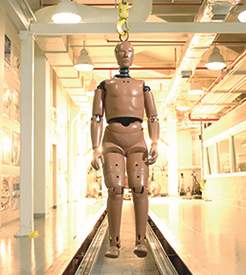Title
The Effect of Booster Seat Use on Pediatric Injuries in Motor Vehicle Frontal Crashes
Document Type
Article
Publication Date
4-20-2018
Publication Title
Journal of Pediatric Orthopaedics
Abstract
Background: Motor vehicle crashes are a significant source of pediatric mortality and morbidity. Studies indicate that booster seats significantly improve seat belt fit for children who have not attained a height of 145 cm (4’ 9”). This study examined injuries occurring in booster age children up to age 12, as the majority of children do not attain 145 cm until this age. The purpose of the study was to identify differences in injuries due to the type of restraint used, with attention to musculoskeletal injuries. Methods: Vehicle and occupant data were obtained from a publically available statistical sample of tow-away crashes. Frontal crashes over an 8-year period were examined. A data set of cases was created involving children ages 5 to 12 years who were unrestrained, restrained using the vehicle’s lap and shoulder belt, and restrained using a booster seat with the vehicle’s lap and shoulder seat belt. Injury severity, frequency, and patterns of distribution were compared. Results: Unrestrained children experienced moderate to severe injuries 3.8 to 19 times more frequently than children using restraints. There were more injuries to the head and face in unrestrained versus restrained children, but the head and face was the most frequently injured region for all groups. There were no serious cervical spine injuries reported for any group. Lower extremity fractures were not observed in booster seat users but occurred at similar rates in both unrestrained and seat belt restrained children. These fractures occurred in older children who were involved in more severe crashes. Conclusions: Unrestrained children were more likely to experience moderate and severe injuries than restrained children. The data sample suggests that booster use may reduce the risk of extremity fracture, as there were no extremity fractures in children restrained with booster seats. Clinical Relevance: This work provides evidence for the efficacy of booster use for preventing orthopaedic injury in children. This evidence can be used to inform parents and establish recommendations for best practices in transporting children.
DOI
10.1097/BPO.0000000000001189
ISSN
1539-2570
Rights
© 2018 Ovid Technologies, Inc.
Recommended Citation
Caskey, Sean; Hammond, Joshua; Peck, Jeffery; Sardelli, Matthew; and Atkinson, Theresa, "The Effect of Booster Seat Use on Pediatric Injuries in Motor Vehicle Frontal Crashes" (2018). Crash Safety Center Publications. 40.
https://digitalcommons.kettering.edu/crash_pubs/40


